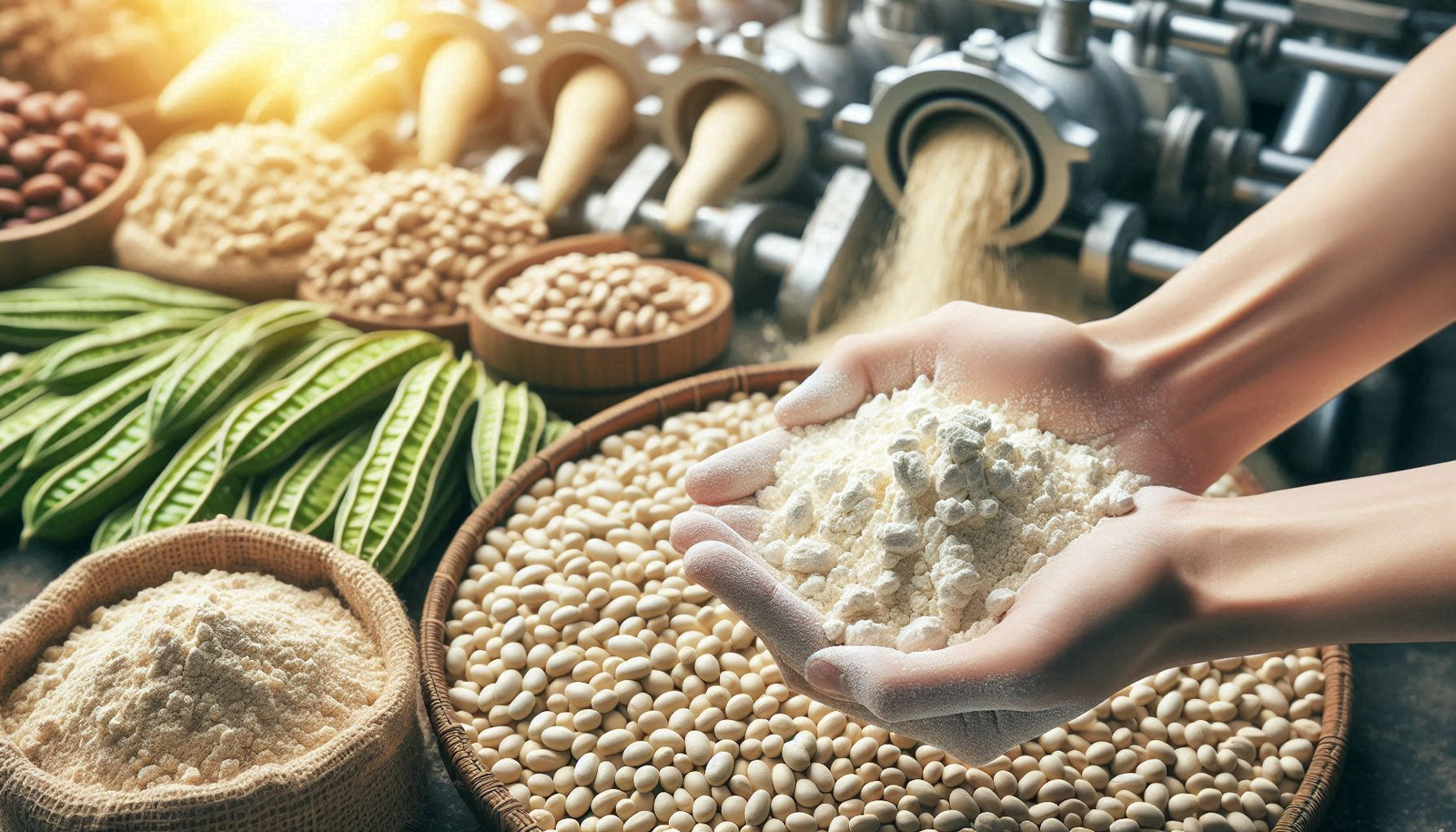Noodles are one of the most beloved foods worldwide. You can find noodles in almost every kitchen, whether they’re mixed into a stir-fry, floating in a soup, or grabbed for a quick snack. But have you ever wondered what goes into making noodles so stretchy, firm, and flavorful? Well, the answer lies in Guar Gum! Guar Gum in Noodles is the core ingredient for some manufacturers because it has enormous benefits.
In this blog, we will explore how Guar Gum in Noodles enhances the texture, shelf-life, and overall quality of noodles. We will also look at how Guar Gum in Noodles contributes to health benefits, and its rising popularity in the food industry. So, let’s dive into the world of Guar Gum in Noodles and discover its key role.
What is Guar Gum?
Before we dive into its role in noodle manufacturing, let’s first understand what Guar Gum is. Guar Gum, also known as guaran, is a natural polysaccharide extracted from the seeds of the guar plant. This ingredient has been used for centuries in various food and non-food products due to its exceptional thickening, gelling, and stabilizing properties.
Guar Gum is particularly well-known in the food industry because it acts as a thickener, emulsifier, and stabilizer. These qualities make it an excellent ingredient for use in a variety of food products, including sauces, soups, ice creams, and, of course, noodles.
The Importance of Guar Gum in Noodles Manufacturing:
Noodle production involves combining several ingredients like flour, water, salt, and sometimes egg. These ingredients are then kneaded and rolled into thin sheets or strands. However, making noodles that are not only edible but delicious and of high quality requires a lot of attention to detail. This is where Guar Gum in Noodles comes in.
1. Texture Improvement:
One of the most important factors in noodle quality is the texture. Noodles need to have the right balance of firmness and elasticity. If the texture is too hard, the noodles become unpleasant to eat; if it’s too soft, they break easily and lack structure. By adding Guar Gum to the Noodles, manufacturers can improve the texture and give noodles a more chewy, elastic feel. The gum absorbs water and swells, forming a gel-like substance, which helps bind the dough together.
2. Enhanced Stretchability:
Guar Gum is an essential ingredient for achieving the perfect noodle stretch. Noodles should be able to stretch without breaking, and this is precisely what Guar Gum in Noodles does. The gum helps maintain the strength and elasticity of the noodle dough, ensuring that the noodles do not snap during preparation or cooking.
3. Improved Dough Consistency:
Maintaining consistency in noodle dough is crucial for uniform texture and cooking quality. Guar Gum improves the dough’s viscosity, allowing for better handling and a more consistent product. The gum works by increasing the water retention capacity of the dough, ensuring that it remains smooth and easy to handle.
4. Moisture Retention and Shelf-Life Extension:
One of the key benefits of Guar Gum is its ability to retain moisture. This is particularly important for manufacturers who want to ensure that their noodles stay fresh and do not dry out during storage. Guar Gum can help extend the shelf life of noodles by maintaining moisture levels, keeping the noodles soft, and preventing them from becoming brittle.
5. Non-GMO and Gluten-Free Benefits:
Guar Gum is a natural, plant-based ingredient, which makes it an attractive option for health-conscious consumers. It is often used in gluten-free noodles as a substitute for wheat-based gluten. This means that individuals who follow gluten-free diets can enjoy high-quality noodles without any concerns.
Health Benefits of Guar Gum in Noodles:
Apart from guar gum’s functional properties in noodle manufacturing, Guar Gum in Noodles also offers several health benefits, which is why it is gaining popularity among food manufacturers and consumers alike.
1. Dietary Fiber Source:
Guar Gum is rich in soluble fiber, which is beneficial for digestive health. When consumed, it absorbs water in the digestive system, forming a gel-like substance that aids in regular bowel movements and promotes healthy digestion. By incorporating Guar Gum in Noodles, manufacturers can provide an additional source of fiber in the diet.
2. Helps Control Blood Sugar Levels:
The fiber in Guar Gum also helps to control blood sugar levels by slowing down the absorption of sugar into the bloodstream. This can be particularly helpful for individuals with diabetes or those looking to manage their blood sugar levels effectively.
3. Supports Weight Management:
Guar Gum can be a useful tool for weight management. The fiber in Guar Gum helps to promote a feeling of fullness, which can prevent overeating and support weight loss efforts. Additionally, the fiber content helps regulate cholesterol levels and promotes overall heart health.
4. Low Calorie and Low Fat:
Noodles made with Guar Gum are typically low in calories and fat, making them a healthier alternative to traditional noodles that may contain added preservatives and unhealthy fats. This makes them a popular choice for consumers seeking healthier noodle options.
How Guar Gum in Noodles Improves the Noodle Industry:
The growing demand for healthier, gluten-free, and functional food products has led many food manufacturers to turn to Guar Gum in Noodles. This ingredient allows for the production of noodles that meet the needs of various dietary requirements without compromising on taste or texture.
1. Increased Consumer Demand for Gluten-Free Products:
The gluten-free food market has seen a significant rise in recent years. As more people adopt gluten-free diets due to celiac disease or personal choice, the demand for gluten-free noodles has surged. Guar Gum in Noodles has enabled manufacturers to create high-quality gluten-free noodles with the right texture and consistency, satisfying the needs of this growing market.
2. Sustainability and Eco-Friendliness:
Guar Gum in Noodles is derived from the guar plant, a crop that is known for its minimal water usage and resilience to dry conditions. This makes guar cultivation more sustainable compared to other crops used in food manufacturing. By using Guar Gum in Noodles, manufacturers can help reduce the environmental impact of food production, making it a more eco-friendly option.
3. Innovation in Product Development:
As the food industry continues to evolve, manufacturers are constantly looking for innovative ways to improve their products. Guar Gum in Noodles has opened up possibilities for creating new varieties of noodles that are both functional and nutritious. This has led to the development of noodles with unique textures, flavors, and nutritional profiles, catering to a wider audience.
Conclusion:
The role of Guar Gum in Noodles manufacturing is undeniable. From enhancing the texture and stretchability of noodles to extending their shelf-life and offering health benefits, Guar Gum in Noodles plays a vital role in the noodle industry. As consumer demand for healthier, gluten-free, and functional foods grows, the use of Guar Gum in Noodles is set to become even more widespread.
By adding Guar Gum in Noodles, manufacturers can create a product that not only meets the quality standards but also provides added nutritional value. The versatility, sustainability, and health benefits of Guar Gum in Noodles make it an essential ingredient for the future of noodle manufacturing. As the food industry continues to innovate, Guar Gum in Noodles will remain a key player in shaping the next generation of noodles.
FAQs:
1. Is Guar Gum used in Noodles manufacturing?
Yes, Guar Gum is used in noodles manufacturing to improve texture, elasticity, and moisture retention.
2. What role does Guar Gum play in Noodles?
Guar Gum in Noodles is a natural ingredient used to improve texture, moisture retention, and shelf life in noodle production.
3. How does Guar Gum in Noodles improve texture?
Guar Gum in Noodles helps make the noodles chewy and elastic, ensuring they don’t break easily.
4. Does Guar Gum in Noodles affect taste?
No, Guar Gum in Noodles does not alter the taste of noodles; it only improves texture and consistency.
5. How much Guar Gum in Noodles should be used?
The amount of Guar Gum in Noodles varies depending on the recipe, but it’s usually added in small quantities for maximum benefit.
6. Are there any guar gum benefits?
Guar Gum in Noodles provides dietary fiber, supports digestion, and helps control blood sugar levels.
7. Why is Guar Gum in Noodles becoming popular?
Guar Gum in Noodles is popular because it enhances noodle texture, supports health, and meets the growing demand for gluten-free products.
8. Can Guar Gum used in all noodle types?
Yes, Guar Gum in Noodles can be added to various types, including gluten-free and regular noodles, for improved quality.
9. Does Guar Gum help noodles stay fresh longer?
Yes, it keeps noodles moist and extends their shelf life.
10. Can Guar Gum be used in instant noodles?
Yes, it’s commonly used in instant noodles for better quality.







